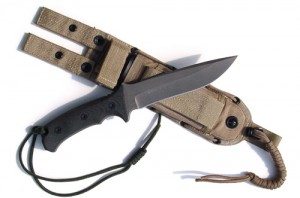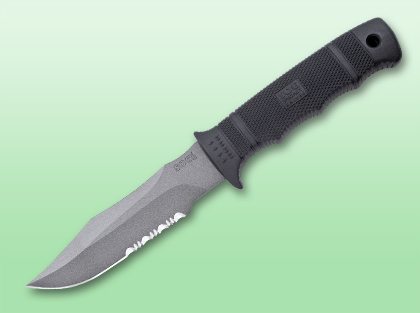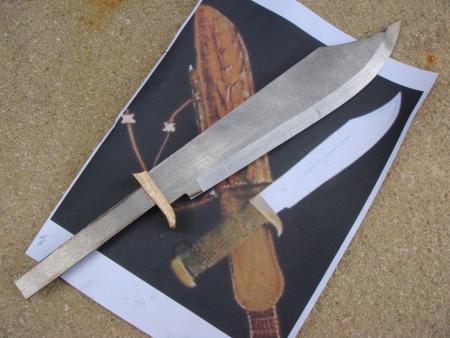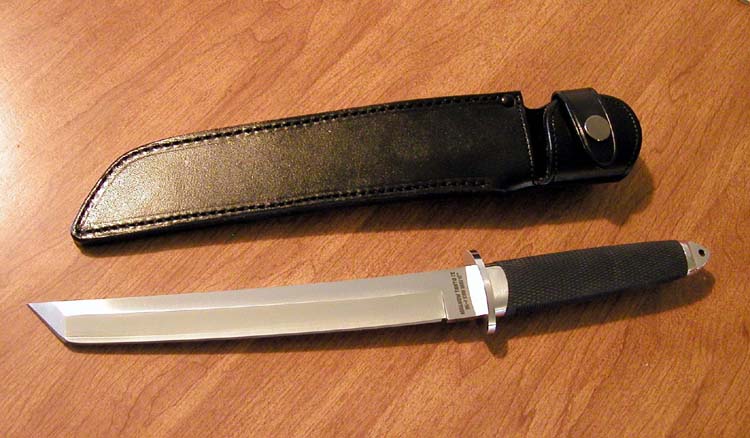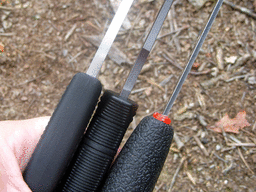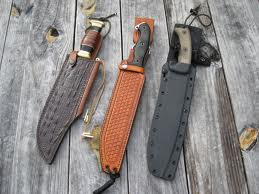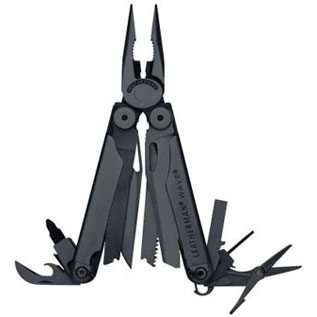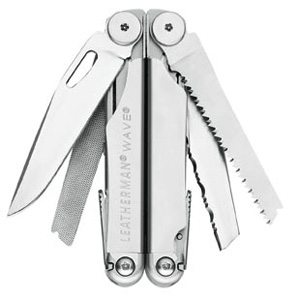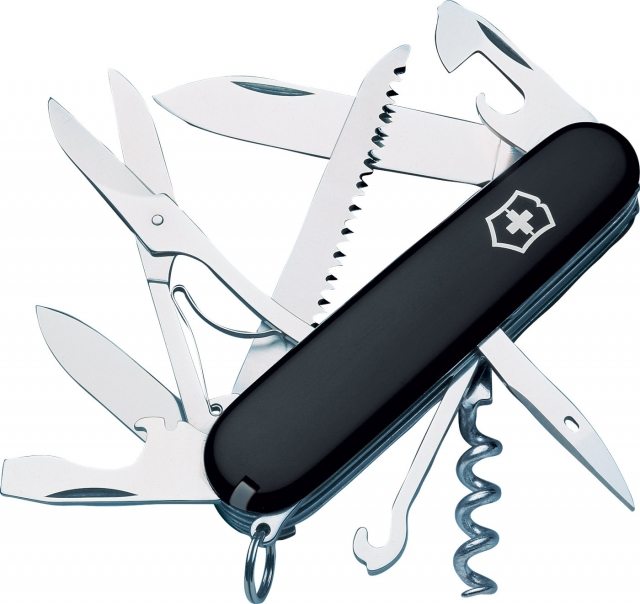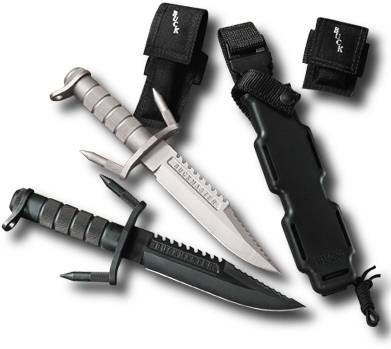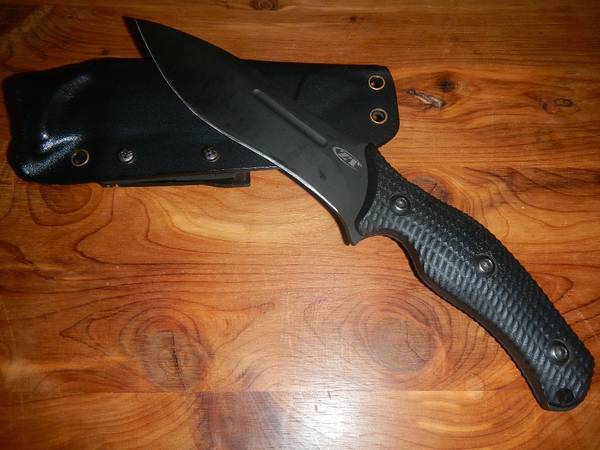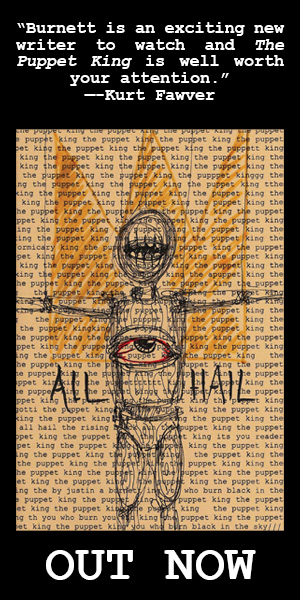Having a good quality blade is something that every prepper should have in their inventory or in their BOB. With the vast market of knives out there it can be extremely difficult to find a knife that you’re comfortable with. Here’s a couple of things to consider when looking for a sheath knife.
A quick refresher, a sheath knife is usually one that is 6â€-12†long.
Let’s cover the basic parts of a sheath knife.
The Tang.
The Tang is the portion of the blade that is inside the handle meaning that a quality knife will have this as one solid piece. A full Tang gives the entire knife more strength. That is something to consider if you ever have to hack a small tree down, cut your way through thick brush or lop off a hostile’s body part.
The Handle
The Handle is the part of the knife that you grip. They are usually made out of hard rubber, polymers or other materials. Most of the knives in the ‘survival’ category feature a hollow handle. Remember what was said about the Tang? Unless the handle and the blade are one continuous piece there is no strength on the knife. Hollow handles are nice but really serve no purpose for a sheath knife as they are a primary weak spot where strength is concerned. Picture prying or chopping and the knife breaking where the blade and handle meet, not a pretty sight. (However, there was one knife that is no longer being made that had the blade and hollow handle as one piece made out of D2 Tool Steel.) A hollow handle knife will not have a full tang therefore be weaker than a full tang blade. Another popular item with hollow handle ‘survival’ knives is the compass in the handle. How cool is it to have a cheap compass on the handle? Seriously, if you ever had the need to use the pommel (bottom part of the handle opposite the blade) to smash in a window or a skull, there goes your $.25 compass.
The Blade
The Blade of any knife, utility or survival, should be metal, duh. The two most common metals used for blades are Stainless Steel and Carbon Steel. Stainless Steel is stainless steel, pretty much indestructible, can take a beating and very rarely rusts. But some people claim that it loses its edge faster than carbon. I don’t know about that as I have a tendency to check my blades monthly and sharpen as needed. Carbon Steel blades are rumored to hold an edge longer but are more susceptible to weather and allegedly rust easier. Like with any tool, proper maintenance and inspection are required. If you get into a pattern of checking your gear and equipment, you can head off any rust or dullness issues.
Blade Shape
Blades shapes for sheath knives are usually Bowie with a recurve style or a Tanto shape. Sure you can find all kinds of blade shapes out there, have one custom made, etc, but the average sheath knife blade shape is one of the above mentioned.
Blade Length
The length for most survival style knives is between 6†and 12â€, any longer and you start moving into the Rambo compensating for something type knife that soon becomes unwieldy, ineffective and dangerous to use not to mention weight.
Blade Thickness
Even if you’re not a knife expert most of us can tell by looking at the ‘spine’ of a knife if it’s thick or not. The spine is the part of the blade opposite the cutting edge or the ‘top’ of the blade. Most quality knives will have a spine thickness of 3/16-4/16 of an inch. A knife with that thickness will be extremely solid and withstand the abuse of wood chopping and prying. Never select a survival knife that has a lot of flex in the blade. Note: I mention wood chopping but in all reality, you should have something else in your gear to do the serious wood chopping. Your sheath knife should be used to handle smaller branches only not take down a tree.
The Sheath
Obviously with a sheath knife you need a something to carry it in, the sheath. Sheathes can be made out of leather, rigid plastic or ballistic nylon. There are three essential items to look for when looking at the sheath.
1)Â Â Â Â Â Lower Attachments. These are usually eyelets or grommets at the tip of the sheath that can allow you to strap down the knife to you leg when carrying it on your belt or attach it to a strap on your gear.
2)     Belt and Lanyard attachment. Does the sheath come with a belt loop? Kind of an important feature if you want to strap it to your leg. Does the knife handle have a hole or someplace to attach a lanyard? This is another important feature as you can ‘dummy’ cord the knife to your belt so in a really bad situation like sliding down a hill or falling off a cliff where you may lose a lot of your gear, your knife remains relatively attached to you.
3)     A Strap. Does the sheath close around the knife? Is there a crossover strap right where the handle meets the sheath? Sheaths with a strap at the base of the handle allow the knife to move therefore could allow the knife to slide out.
Don’t worry too much about sheathes at this point. A follow-on topic will discuss sheathes in far greater detail. What is listed above is just the general information on what to look for.
What comes to mind as a good quality sheath knife is the Ka-Bar USMC combat knife. Maybe replace the sheath with a jump sheath to add in some versatility and you have a survival knife that is relatively inexpensive yet very durable. After all, they made it for Marines to use. Way back in the day, I carried my grandfather’s 1942 USMC issue Ka-Bar in a jump sheath when I was out in the field.
Utility Blades
While a sheath knife may not work in all situations or for our EDC (Every Day Carry), a small, yet capable utility blade might be more suitable.
Utility blades are just that, designed for small jobs and other utility type tasks. A pocket folder knife or a multi-tool fit the definition of utility. We all have our preferences and there are literally thousands out there to choose from so I’m only going to mention the ones that I’m familiar with. (This does not mean that because I mention and use the following type utility blades that you are in any way required to run out and purchase them.)
I carry two, sometimes three, utility blades. The primary, EDC utility item is the Leatherman Wave multi-tool. I prefer this model as all the primary blades lock in place when extended preventing a fold back injury. A fold back injury is when the blade folds back over your hand and/or fingers. Never a good thing. So right off the bat we know that if we’re looking for any kind of multi-tool you want one that has the locking feature for the primary blades. That means avoid the knock-off All Trade multi-tool that you see around the holidays and Father’s Day.
The second blade I carry is the Swiss Army Victorinix. This is a basic model Swiss Army knife and it features most of the same blades as the Leatherman Wave except none of the blades lock in place when extended. I use this one as a backup to my Leatherman.
The third utility knife that I occasionally carry is a Schrade CH7 lock blade. (Notice the subtle hint about locking blades?) It’s a basic lock blade folding knife with a Zytel handle and a small serrated edge near the handle. I usually keep it in a Brigade Quartermaster sheath on my field gear. The picture is a generic Schrade lock blade but if anyone is interested in the CH7, Target usually carries them in the sporting goods section for about $12.00.
That about ties up the topic of blades. Remember to look for the options listed above when shopping for a sheath knife and consider a locking blade feature if shopping for a multi-tool or folding knife. We all have our own preferences and carry methods. What I described are mine and not in any way required for you to emulate.
In case anyone is wondering what sheath knives I use, way back in the late 1980s when I was just a lad, I spent an entire summer’s wages and bought a Buckmaster 184 knife. This is one of the few hollow handle survival knives that the handle and blade are machined as one piece therefore there is some really solid strength behind that blade. But, it’s very heavy and usually stays strapped to my pack unless I need to chop down a redwood or carve my way into bank vault. This is the knife I mentioned above that is machined out of one piece of D2 Tool Steel, blade and handle being one unit, making it incredibly solid and durable. Sadly, this knife was discontinued about 1989-1990.
My primary sheath knife that I use when outdoors, teaching a class, hiking or camping or working on my woodcraft skills is a SOG SEAL Pup, but that may change as I’ve recently been using a Zero Tolerance 0100 knife that has so far, impressed me quite a bit.

